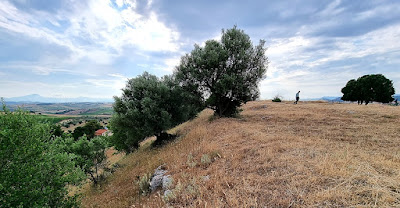In the past, the relationship between classical archaeology and the physical sciences, two very broad fields, was distant and somewhat contentious (see this article from 1981 summarizing the state of the debate at that time: https://www.jstor.org/stable/1356543).
Today, all archaeologists working in Greece, to one degree or another, recognize the value of scientific methods, theories, and technologies for an evidence-based and accurate reconstruction of the past. Field archaeologists working collaboratively with and actively as scientists have transformed our understanding of the ancient world. At ancient Eleon in central Greece, the synergasia between the Ephorate of Antiquities of Boeotia and the Canadian Institute in Greece, represented by the University of Victoria and Wellesley College, has embraced scientific approaches since we began our work in 2007 (https://ebapexcavations.org/). Scientific methods became especially important when excavations began in 2011. We collected material for scientific analysis to better establish chronology, to understand past diet, to learn what technologies were being employed for the production of pottery, to map what resources were being exploited in the environment, and most recently, to understand the health of individuals uncovered in our burial complex, the Blue Stone Structure. We have facilitated the work of research specialists with projects focused on starch grains from ground stone tools, residue analysis and neutron activation analysis on pottery, scanning electron microscopy of ancient textiles, and ancient DNA studies on our human bones. In 2021, we were able to conduct a very successful program of geophysical survey using techniques of gradiometric magnetometry and electro-resistivity to provide a picture of where we might direct future investigations at ancient Eleon, and to better understand architecture that has already been revealed.
In addition to these projects, we were able to collaborate with three emerging scholars as they use scientific approaches to Eleon material to understand the past: Janelle Sadarananda, PhD candidate, Graduate Group in Art and Archaeology of the Mediterranean World, University of Pennsylvania; Amanda Gaggioli, PhD candidate, Stanford Archaeology Center, Classics; and Marion Sirito-Olivier, PhD candidate at the Université Paul Valéry Montpellier III and member of the l’École française d’Athènes (EFA). We’re excited to share a little about the work of these colleagues, and look forward to their continued work at Eleon!
Janelle Sadarananda taking clay samples
Janelle Sadarananda has been a member of the Eleon team since 2013, working as an excavator, collections manager, and problem-solver. She is now focused on the crafts and landscape of Eleon during the Archaic and Classical periods for her PhD dissertation on ceramic production and resource exploitation. Her petrographic analysis of the many Boeotian Kylix Ware vessels found in votive assemblages at Eleon has identified multiple fabric groups that suggest numerous places of production for a ceramic style that is largely consistent across the region. This season, Janelle was able to collect geological samples to assess clay sources representative of the immediate environs of ancient Eleon, and across a broader swath of eastern Boeotia. Her further analysis of ancient petrofabrics and the distinctive geological profile of Boeotian clays will reframe our definition of “local” ceramics, and inform our conception of economic and cultural networks within central Greece.
Amanda Gaggioli working on micromorphological samples
Amanda Gaggioli has begun a study of soil micromorphology at Eleon aimed at a better understanding of funerary behavior and the construction of Eleon’s Blue Stone Structure. Bringing expertise of geoarchaeology and site formation, developed in part through her dissertation documenting earthquakes in the archaeological record, Amanda is now processing soil samples taken during earlier fieldwork seasons by our conservators and indefatigable site architect, Giluliana Bianco. Once thin sections have been prepared, Amanda’s analysis will help us understand the sequence of depositions within Tomb 5 and help to distinguish phases of construction of the clay tumulus that eventually covered the BSS. An initial round of FTIR (fourier transform infrared) spectroscopy has demonstrated that mudbricks incorporated into the tumulus fill were unburnt, despite visual characteristics that led to this characterization in the field. Comparison with additional samples will determine if there is variation in the source of tumulus clay and its treatment.
Marion Sirito-Olivier analyzing animal remains
Marion Sirito-Olivier studies breeding strategies and meat supply in central Greece during the Bronze Age. For her dissertation at Montpellier, she is conducting comparative analysis of zooarchaeological material from Eleon,Kirrha and Tria Alonia (Phokis), to assess differences in the management of animals resources, to compare economic and cultural practices of central Greece to those of other regions. Within her analysis of Eleon’s copious archaeozoological remains, she is prioritizing specific analysis on sheep, goat, and cattle. Her study of mesowear and microwear patterns on their teeth tells us about the management practices for this domestic livestock by observation of their alimentation. Future analyses of stable carbon and nitrogen isotopes will provide further information on animal feeding strategies, and how they may have changed over time.
EBAP/Eleon study season and geophysical team
These are only a few of the very interesting and important research projects being conducted at ancient Eleon. In future posts, we hope to discuss the work of colleagues working on obsidian and chert stone tools (Scott Evans), terracotta figurines (Haley Bertram), ceramics (Drs. Trevor Van Damme and Bartek Lis), and our multiple team members studying the human remains from the burials at Eleon (Professor Nicholas Herrmann, Krysten Cruz, and Adrienne Stainton). After a hiatus in work during 2020, like most field projects in Greece and across the world, it was great to have a small team back for our 2021 season (photo 4), With little advance notice, these experts rearranged schedules, navigated travel challenges, and followed new protocols to resume the study of material from ancient Eleon safely. We appreciate the continued collaboration with colleagues at the Archaeological Museum of Thebes (https://www.mthv.gr/en/) and decade-long connection with neighbors and supporters in the communities of Arma and Dilesi.
Bryan Burns and Brendan Burke
Wellesley College & University of Victoria; co-directors of Eleon Excavations






No comments:
Post a Comment